MAY’S ENDURING MAGIC
Much of this month’s main coverage is a moderately revised version of material found in my book, A Smoky Mountain Boyhood. If you don’t have a copy of this work, with which I was fortunate enough to win multiple awards including an Eppy, details are available on my website (www.jimcasadaoutdoors.com). Hopefully you will find the musings on May that follow enjoyable and, better still, highlighting some shared experiences.
For a wide variety of reasons, I have always found May magical. Along with October, which certainly gives it a run for the money, it’s my favorite month of the year. Poet James Russell Lowell waxed eloquent with his question “What is so rare as a day in June?,” but had my native Smokies and much of the Southland been his homeland and the geographical source of his inspiration, he would assuredly have chosen the month of May. He would even have gotten some internal rhyme in the bargain. Or take the apt description from Shakespeare’s King Henry IV, “as full of spirit as the month of May.” The spirit of the month comes in varied forms. It’s a time of early harvest, of gardens beginning to show real promise, of bedding bream and rising trout, and of spring in all its lushness. The threat of frost is gone, but nights remain comfortable or even a tad chilly, while daytime presents none of the withering heat and humidity to be faced in coming months.
Here, in no particular order of importance, is a sampling of some of May’s myriad delights as I have savored them over the decades. It’s a month that sets my proclivities for indulging in nostalgia into overdrive as I look back on all its days meant to me as a boy. The end of another school year was in sight, and not even the looming threat of semester’s end exams could entirely dim the luster of that fast approaching and glad day. The weather had reached a point where it was fairly predictable, and that translated into opportunities for weekend camping/fishing trips in remote regions of the Smokies adorned with all the splendor of returning spring.
Beyond that, the month held wonder in its hand in so many ways, and for an adolescent those were wonders to be embraced and enjoyed. Maybe the best way of depicting May, as I have known and loved the month, is through resurrecting some of those miracles of green-up time in the high country.
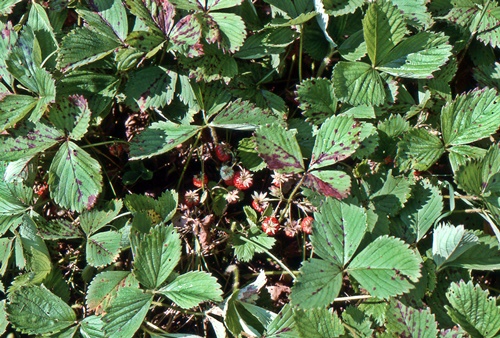
*May meant ripe wild strawberries which were, in the 1950s, available in great abundance in old farm fields and open areas that had once been farms. These spaces had not yet reverted to forest and wild strawberries, along with dewberries and blackberries, thrived in them. Wild strawberries were tedious to pick, equally demanding when it came to working them up, fragile, and did not keep well. Moreover, they carried a real possibility of confrontation with a copperhead or rattlesnake. Yet the taste of wild strawberries more than made up for all those shortcomings and danger. Over shortcake, sliced atop a bowl of vanilla ice cream, made into a trifle, in home-churned strawberry ice cream, used for preserves or jelly, topping for cereal, or just eaten by themselves, they offered a small sampling of pure culinary paradise. Izaak Walton knew whereof he spoke when he said: “Doubtless God could have made a better berry, but doubtless God never did.”
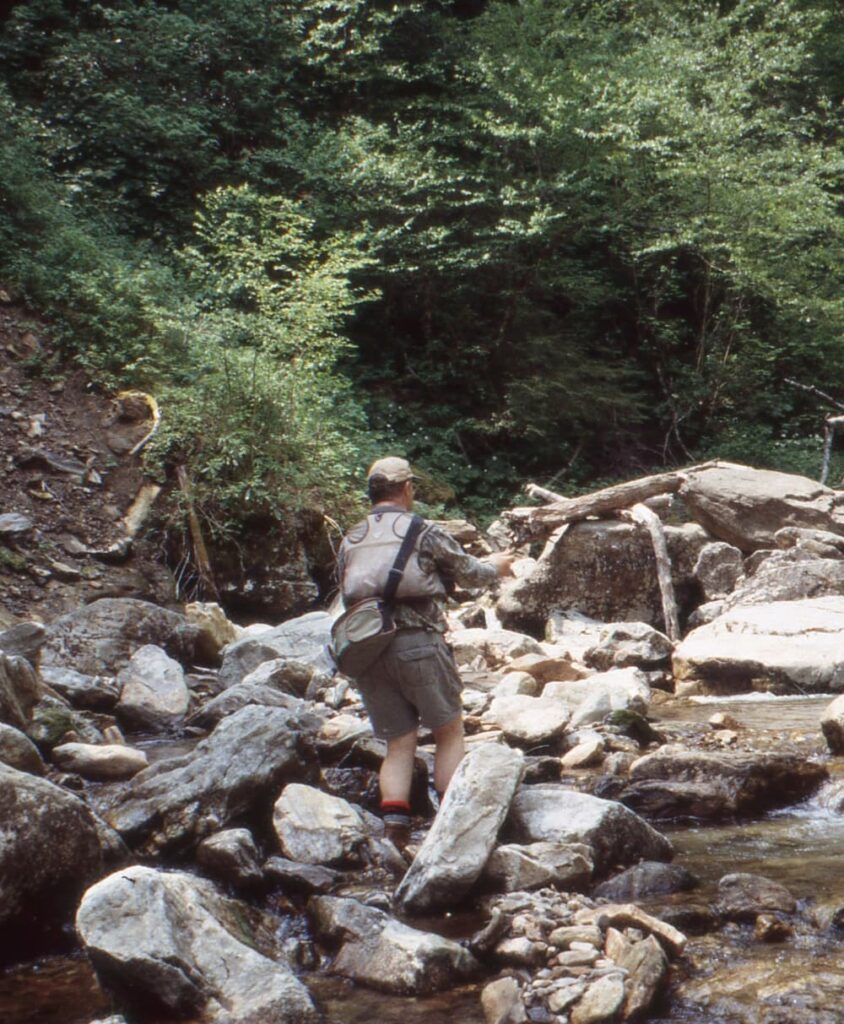
*May meant fishing for trout, and after the winter doldrums warming water temperatures put them on the prod and brought joy to the heart of a boy who, according to his father decades later, had squandered away half his life “fooling with fish.” Camping trips in the back country were a traditional part of my angling experience. The first weekend in May brought the opening of trout season, and I don’t think I missed an opener from the time I was eleven or twelve years of age until I went off to college. Most backpacking trips involved the headwaters of my “home” stream, Deep Creek, at a place known as Poke Patch. Wading could sometimes be mighty cold, as could sleeping arrangements. I didn’t own a sleeping bag so a single Army blanket constituted my bedding.
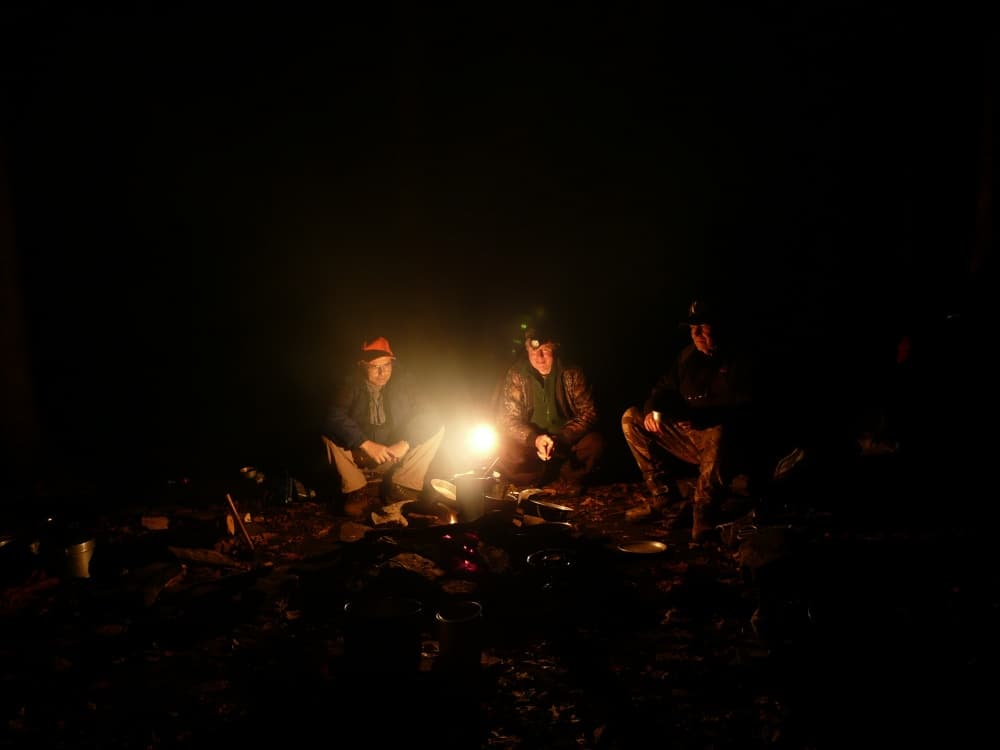
Yet what I’d give for a May night or two at a backcountry campsite, bone-tired but with a cheery fire before me, trout frying in the pan, potatoes and onions in a second skillet, and a “kilt” salad of ramps and branch lettuce waiting in the wings. I’ll take such a setting and such fare over anything a five-star restaurant with a hoity-toity chef, majestic maitre d’s, and ever-attentive waiters can offer. Fresh from the stream and properly prepared, trout are a gift from the food gods.
*It was a time for enjoying the garden’s early produce. Spring onions, radishes, new potatoes, black-seeded Simpson lettuce, spinach, mustard greens (we planted them spring and fall), and other delights would have “made” by mid-May, and in a most gratifying fashion they signaled that months of incredible garden bounty were in the offing.
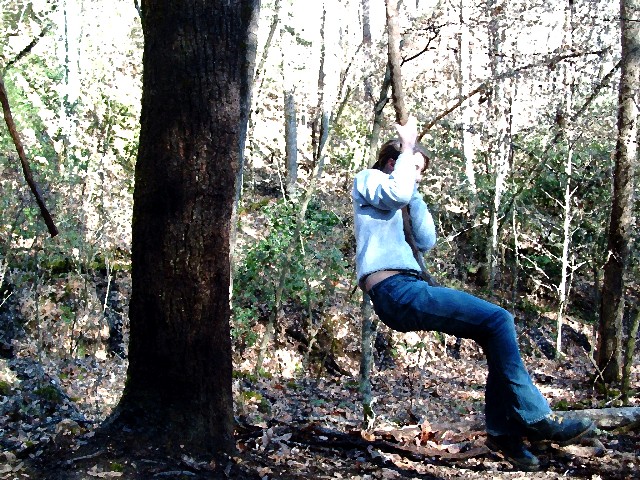
*May meant boyhood games of the kind that required no formal organization, no adult supervision, and indeed nothing but a bit of youthful ingenuity and an abundance of energy. Rolly-bat, marbles, slingshot competitions, bike riding, rock skipping at the river, endless sharpening of knives and whittling, building forts, swinging on big grape vines, “riding” slender pines or poplars, and other carefree activities filled hours without number in my youth.
*The month also began the swimming season. Other than a couple of surreptitious nighttime excursions into a pool owned by a local inn, I’m not sure I ever swam in a man-made pool until I was grown. Certainly I was able to swim long before I ever paddled in anything other than a creek or river. May was pushing things on the swimming front, but the first dip in icy cold Deep Creek, leaving your lips blue and your body covered with goose bumps in no time at all, was at once an obligation, an annual rite of passage, and a joy.
*As an adjunct to swimming May brought a resumption of float tubing. That involved drifting down the creek on an inner tube, back when all tires came with them and when they were made of real rubber, happy as a lark and heedless of all cares. This was usually done after a big rain when the creek was high and the ride was an exciting one not only because of the rapidity with which the creek moved but because the limbs of bushes and low trees overhanging the creek held scores of water snakes. No matter how many times you experienced one of them dropping atop you or just alongside the tube, there was always an element of fright and an involuntary yell. Today tubing is big business on readily accessible streams throughout the region, and I’d as soon walk around Times Square in New York City as to mingle with the flotillas which sometimes seem to cover creeks in the Smokies from bank to bank. In boyhood though, my friends and I invariably had the creek to ourselves.
*May, or more accurately the latter part of the month, marked the advent of the barefoot season. I’d be begging to shed shoes before April was well under way, but Momma wouldn’t have any part of such foolishness until a fortnight or so before Memorial Day. But when the time came for “barefootin’ it” how joyous it was to shed footwear. Today, plagued by neuropathy and with my feet constantly “on fire,” I long for those days and take mental comfort in old-time folk medicine approaches turned modern that suggest walking with one’s skin in contact with the good earth (called “earthing”) has positive effects.
*May was a grand month for catching and selling night crawlers. Warm spring showers brought thoughts of procreation to the worm world, and when that happened those giants of the underground did exactly what their name suggested—they crawled at night. With an evening of joyful effort a spry young fellow equipped with a flashlight, a big bucket with some moss in it, and a quick hand could catch what for a boy amounted to a minor fortune. Night crawlers brought a penny apiece, and earning three or four dollars for a few hours “work” was big money in the 1950s. It wasn’t really labor at all but rather a nocturnal delight. Mind you, I’m sure that much stooping, bending, and grabbing would bring a quite different perspective from me today (and overall soreness on the morrow).
*It was also a time for catching spring lizards (that’s what we called them, though they were actually salamanders) to sell to bait stores. Good ones fetched three cents apiece and the red speckled ones brought a nickel. Much like dealing with night crawlers, this involved quick hands and scrambling in seep branches and springs while turning over rocks. I had a female classmate, Maxine Freeman, whose whole family “hunted” lizards, and the endeavor was actually an important source of income for them. They did it using a technique almost like fishing. I now know that it’s easier to catch them that way, but my spring lizarding was a “grab ‘em when you can” pursuit.
Like gathering ramps in the Park and a lot of other activities I took for granted as a boy, this is something which is, in the words Georgia politician Zell Miller used in a book title, “purt nigh gone.” There are severe limitations on what types of salamanders are legal and today’s youngsters for the most part lack the gumption, not to mention the knowhow, such pursuits require.
*A small bit of the cash earned from catching night crawlers and spring lizards would be wasted, because no Bryson City boy worth his salt could resist putting a few pennies on the railroad tracks. I’m sure this was illegal, although I’d like to think it wasn’t dangerous. All I know for certain is that the trains which ran through town did a marvelous job of flattening out copper wheat pennies. If you know the phrase, “flat as a flitter,” it was certainly applicable in this case.
*In the final years of my high schooling, May meant junior-senior proms. While my number one interest throughout adolescence was outdoor activities, it would be wrong to suggest I studiously ignored the fairer sex. I still harbor fond memories of my senior prom and can mentally walk through everything involved from when I first picked up my date (a former “steady” girl friend who had rightly ceased to be my steady when I got involved in some silly “two-timing”—I doubt the word “steady” or the phrase “two-timing” get much if any usage today) at the home of her aunt and uncle right through to evening’s end.
*More than anything, the magic of May meant just being a boy. I look back with longing on those carefree days. No planning was necessary when it came to after-school hours or weekends. Alone or with other boys I might decide to go seining for minnows, indulge in an hour or two of knife sharpening and whittling, play some mumblety-peg, laze along the riverbank waiting for a bobber to bounce, pick wild strawberries, take a hike with my slingshot or BB gun in hand in search of adventure, admire wildflowers growing close to home, or spend the day with my grandparents. Simple things brought sublime pleasure, and looking back I realize that I was truly blessed in enjoying a Smoky Mountain boyhood. The title of a book by one of my favorite outdoor writers, Archibald Rutledge, Those Were the Days, pretty well sums up my memories of May in yester-youth.
********************************************************************************
JIM’S DOIN’S
Recent weeks have seen me lazing around and earning top-of-the-class grades as I study ways to be what my Grandpa Joe would have called a “lazy bones” or a “trifling no good.” That translates to lots of reading, mixing a bunch of easy read mysteries with a new 1000-page plus biography of Mark Twain by Ron Chernow. I’m exaggerating, more than a little, about my inactivity. A solid work ethic is so deeply ingrained in me that I start feeling guilty if I’m not seeing visible or measurable accomplishments, but honesty compels me to admit that neither my drive nor productivity are what they once were. Likewise, I find myself increasingly inclined to look back rather than looking ahead. Such is the special province of advancing age, but it doesn’t mean I can’t get excited by some project, a particular writing assignment, or a simply development in the yard or with fruit trees or berry bushes.
My recent publications include my regular weekly column in the Smoky Mountain Times, where I’ve been looking at the life of an old river rat with whom I spent a lot of time as a boy only to learn, many years later, that he was a convicted murderer. Other publications include “Spring Tonics,” Carolina Mountain Life, Spring, 2025, pp. 118-19; “Luring in the Gobblers,” Columbia Metropolitan, Apr., 2025, pp. 44-48;“Offbeat Mountain Edibles,” Smoky Mountain Living, Apr./May, 2025, pp. 8-11; ”Digging Ramps in the Spring,” “Blind Pig & the Acorn,” April 29,2025; and ”My Dog of a Lifetime: Coming of Age with Chip,” Columbia Metropolitan, May, 2025, pp. 96-98. The latter is a tribute to a gifted beagle that was my constant companion during boyhood, and to this day I have grand memories of a grand hunting dog.
************************************************************************************
RECIPES
All of the recipes below focus on spring or dishes suitable to the season. They come from the cookbook, Celebrating Southern Appalachian Food, I co-authored with Tipper Pressley. Copies of the book are available through my website or you can order by mail (Jim Casada, 1250 Yorkdale Drive, Rock Hill, SC 29730). The lavishly illustrated book, with some 200 recipes ranging widely over the food spectrum, is $24.95 +$6 shipping.
PAN-FRIED TROUT
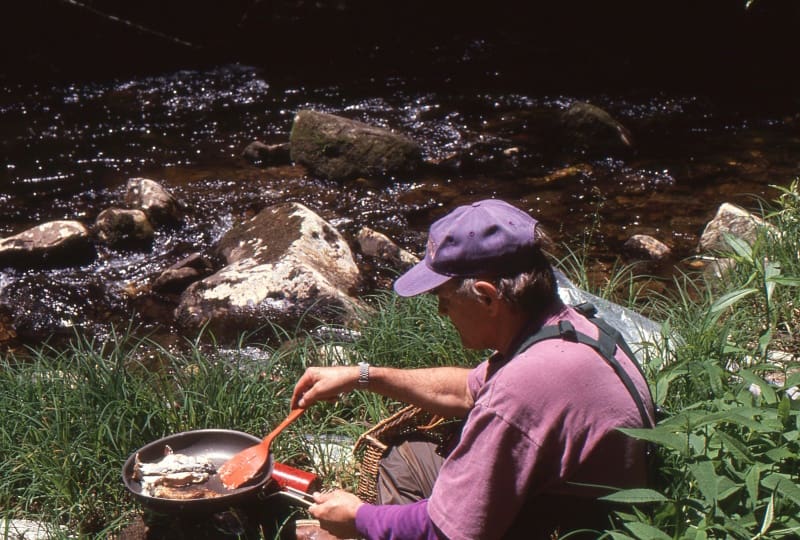
2 to 3 small trout (6 to 8 inches length is ideal—they are tastier than larger ones) per person
Stone-ground cornmeal
Salt and pepper
Bacon grease, lard, or vegetable oil
Clean the fish and leave damp so they will hold plenty of corn meal. Put your cornmeal in a bag, add the trout, along with salt and pepper, and shake thoroughly, making sure the body cavity gets coated. Place the trout in a large frying pan holding piping hot grease. Cook, turning only once, until golden brown. You can help the process along by using a spatula to splash grease into the open body cavities. Place cooked fish atop paper towels, pat gently to remove any excess grease, and dig in.
NOTE: Quite small trout, in situations where it is legal to keep them, can be fried sufficiently crisp to eat bones, fins, and all.
TROUT BAKED IN FOIL
While I’d argue, perhaps with some vehemence, that nothing quite matches fresh-caught trout fried over an open fire in a backcountry campsite, perhaps with a side dish of ramps and branch lettuce or fried potatoes and onions, you can skip the grease and use foil for the cooking process. This works on an open fire if you know what you are doing with coals, on a backyard grill, or in the kitchen oven. Place each whole, dressed trout in its own container of tinfoil, folding carefully so everything stays inside. Line the body cavity with a couple of pats of butter, insert thin slices of lemon, or dust with whatever combination of herbs appeals to you (dried parsley, perhaps with just a touch of red pepper flakes, is particularly good). Cook until the flesh easily flakes from the bones, and be aware of the fact this won’t take long.
CREAMED PEAS AND NEW POTATOES
Both peas and potatoes have long been favorites in mountain gardens, and for many generations the latter, thanks to a combination of productivity (you can grow a lot of potatoes in a relatively small space) and keeping qualities, was a staple vegetable perhaps second only to corn in overall dietary importance. Fortuitously green peas and potatoes reach the edible stage about the same time in late spring, and combining them in a delicious dish was commonplace. In today’s world you can buy new potatoes at any time of the year and frozen English peas make the other part of the classic combo something that can be enjoyed through all seasons.
The “creamed” can be a bit misleading, since no cream, just milk, is involved in the dish. Keep in mind that this is a foodstuff, unlike so many, which tends to be lacking in salt. That’s because there’s no salt, other than the small amount present in salted butter, present in the ingredients. You can just salt and pepper taste if the amount suggested leaves the vegetable mix tasting bland.
12 medium-sized new potatoes
1 cup fresh or frozen garden peas
1 tablespoon salted butter
2 tablespoons diced sweet onion
1 tablespoon all-purpose flour
1 cup whole milk
1 teaspoon salt
Ground black pepper
Scrub potatoes with a vegetable brush to remove skin or else wash carefully and leave skin intact. Cut in half unless some are quite small. Mixed sizes will be the case with those dug from the garden while grocery store ones will have relative uniformity. Place in enough boiling water in a saucepan to cover and cook until barely tender (about 10 to 12 minutes—you can test with the point of a sharp knife), drain in a colander, and set aside. Cook peas in another saucepan of boiling water (required time will be less, perhaps 5 minutes) and drain and set aside as well.
Melt butter in a large skillet and add onion in medium heat, cooking until translucent. At that point add flour, stirring constantly with a whisk, and cook for a minute or so. Then slowly add milk, again stirring all the while, until everything is well combined. At this point add peas, potatoes, salt, and black pepper. Reduce heat to a slow simmer and allow to thicken until the sauce is slightly creamy. Adjust salt and pepper, by taste testing, adding more if needed. Pour into a serving dish or bowl and enjoy. This makes a hearty main dish for an all-vegetable meal or a grand side dish with fried or roasted chicken.
“NEW” POTATO SALAD
There’s something particularly appealing about the texture and taste of new potatoes. Here’s an easy-peasy way to make a potato salad, liberally laced with boiled eggs, and it’s fit for the pickiest of appetites.
3 to 6 boiled eggs, chopped.
Roughly 3 times the volume of eggs in new potatoes.
½ to 1 cup coarsely chopped sweet pickles (amount depends on how much you enjoy their taste).
Mustard and mayonnaise to taste—make sure you have enough to make the salad creamy.
1 teaspoon dried dill weed or 1 tablespoon finely chopped fresh dill
Salt and pepper to taste
Paprika
Boil eggs and set aside when done. While they are boiling, cut potatoes into chunks and boil in a second pot until just tender. Drain and set aside while peeling and chopping the eggs. Place eggs and potatoes in a large bowl, add the sweet pickles, and then stir in mustard, mayonnaise, dill weed, salt, and pepper. Sprinkle the finished potato salad with a really hefty dusting of paprika and place the bowl in the fridge to chill.
TIP: If you like raw onion, chop up a large Vidalia onion and add to the bowl.
ASPARAGUS CASSEROLE
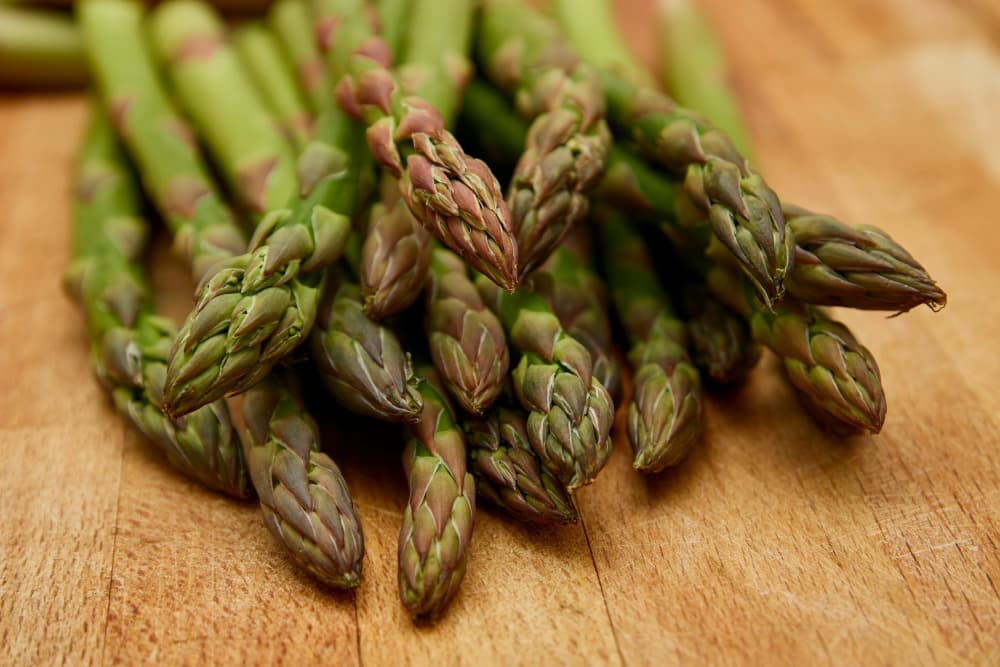
Much like the situation with rhubarb, asparagus is a perennial normally relegated to a location where it can be productive year after year with minimal care—occasional infusions of manure, weeding combined with mulching to allow it to grow without competition, and due diligence to avoid disturbing the roots come plowing time. A properly maintained asparagus bed will remain productive for many years, and the tender shoots offer a springtime treat of sheer joy. Whether stewed with a bit of butter, steamed, grilled, coated in olive oil and prepared in the air fryers which have of late become all the rage, or as the central ingredient in a casserole (the recipe offered here), asparagus is an upscale vegetable that does wonderfully well in high country gardens.
MAIN INGREDIENTS
30 spears of asparagus (or one large can)
3 hard-boiled eggs, sliced
1 cup grated sharp cheese
WHITE SAUCE
Blend 2 tablespoons of flour, 2 tablespoons of butter, ¼ teaspoon salt, ¼ teaspoon black pepper, and 1½ cups Carnation milk. Cook in a double boiler, stirring until thickened and smooth.
Alternate layers of asparagus, eggs, cheese and sauce. Bake in a 350-degree oven for 20 minutes.